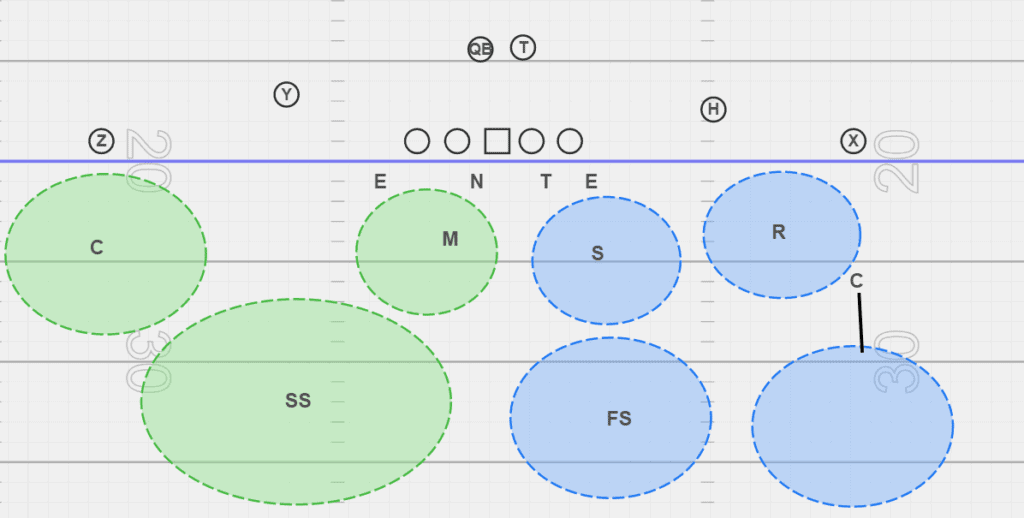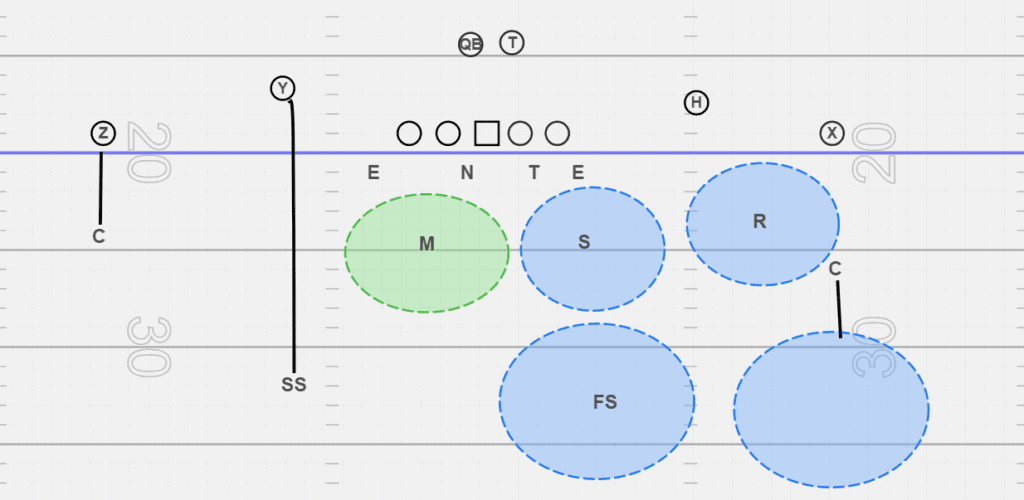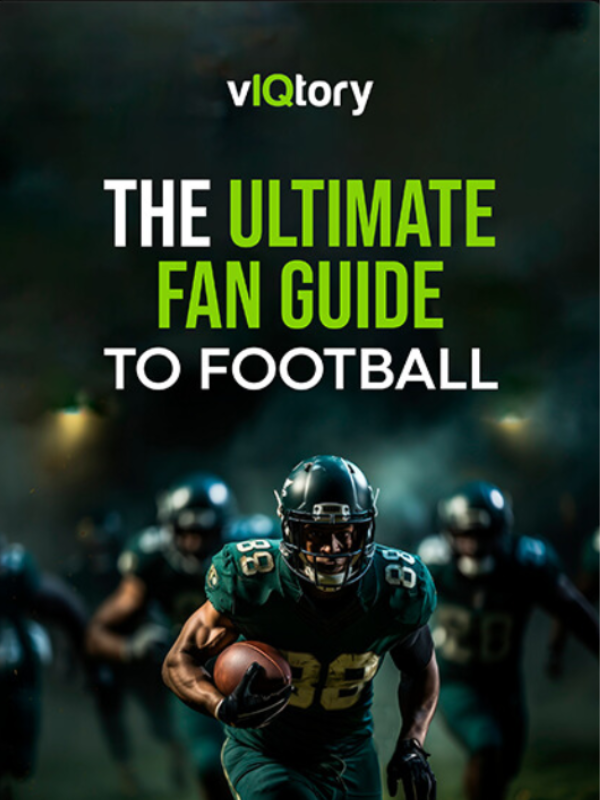Split-field coverage in football is becoming more and more popular as defenses try to defend against the offense’s aerial attack. Teams are starting to play more split field coverages to get more players into open space and fewer reduced space players.
What is split field coverage in football? Split field coverage is when half of the defense plays one coverage, and the other half plays a different coverage. These two coverages are often played based on field position and the number of receivers on the field.
This article will break down split field coverages and how teams use them to cover spread offenses.
Split Field Coverage In Football
To fully understand split field coverages, you first must know how to read them. Often coaches and players will look at the number of safeties and assume that two high safeties mean it’s cover 4 or cover 2.
However, with more teams playing split field concepts, it’s important to look at the linebackers combined with the safeties. Teams who run two high safeties and four defensive linemen will often have three linebackers to cover ten personnel (4 wide receivers).
Another concept to learn when understanding split field coverage is “field” and “boundary.”
When determining where to set their split field coverage, these are popular terms by coaches. For instance, if the ball is on the left hash, there is more room to run or throw the football to the right side. If the ball is on the right hash, there is more room to throw the football to the left side.
Where there is more room means more space and more opportunities for big plays. Coaches will often put their extra linebacker to the field side (the open side) and fewer linebackers and players to the boundary (less space side).
These linebackers will be able to tell you everything you need to know about the coverage. Let’s look at our first split field coverage and how you can identify it.
Why Play Split Field Coverage?
Split field coverage allows coaches to be multiple in their play call. Instead of telling the entire field they’re playing cover 2 or cover 4, they can now split it and play different coverages on each side. This allows the coach to gameplan to certain formations and not be so predictable with every coverage.
Split field coverages also put defenses in a better position to be multiple based on TEs or WRs in the game.
Last, the split field coverage look allows the two high safeties to get into the run fit. Often they will play at 10-12 yards and are the team’s best tacklers. This allows coaches to get two extra players into the run fit to help on the outside runs.
Now let’s look at some of the more common split field coverages in football.
Cover 6
Cover 6 in football is one of the most popular two high, split field coverages. Cover 6, otherwise known as a quarter, quarter, half, means that half of the field is playing quarters coverage, and the other half is playing cover 2.
You can see that the quarter’s side (cover 4) has one extra linebacker to its side in the picture above. This means the back side will have one less linebacker. The coach uses this extra linebacker to cover the open space to prevent the offense from running into the open space.
The boundary side will play cover 2 (or half field coverage). This means the backside, box linebacker, corner, and safety are responsible for the boundary side’s receivers. Less space to the field means less area to cover, which means the defense needs fewer players.
Cover 6 is one of the most common split field coverages to both a 2×2 look and a 3×1 receiver look.
Learn How To Watch Film Properly…
Uncover your opponent’s offensive and defensive tendencies so you can easily build a game plan.
Inside You’ll Find:
- Strategies to pick apart defenses
- How to identify player weaknesses
- How to save time in your weekly breakdowns
Cover 4 & Man Coverage
Another version of split field coverage is to play cover 4 to the field side and then man the backside. This allows teams to dedicate that backside linebacker completely to the box, so he doesn’t have to worry about playing the pass. He will drop into zone coverage when it is a pass and help with the underneath receivers.
Teams who often run this version of Cover 4 and man coverage are 4-2-5 teams. They will dedicate their two linebackers to the box and have their extra defensive back play quarters. The back side will play man coverage on any single or 2×2 set.
Cover 4 & Palms Coverage
Our last variant of split field coverage that we will review in this article is the ability to play Cover 4 and Palms coverage in combination.
This means that the front side of the formation is playing cover 4. Meanwhile, the backside, instead of playing man or cover 2, will be playing palms coverage. We’ve down a complete breakdown of palms coverage here, which you can install into your defense immediately.
The rules are simple. The corner will take the first man out to the flats. Many teams will call this their cover 2, as they will sink the corner, and he will take first to flat. Whatever you call it, you can mix it up any way you want.
These, of course, are only a few ways that split field coverages are played. If you’re looking for more options on split field coverages, you can visit Coach Cody Alexander‘s website matchquarters.com, or get his book here on Amazon.
Want To Learn More About Coverages? See Our Complete Defensive Coverage Guide Here
Keep Learning
If you’re a coach and want to keep learning about your position we recommend you check out our University courses below. It will help you become the smartest coach on your staff.
We’ve created the Ultimate Football Guide to help you improve your football IQ. Check it out below.
Ready To Increase Your Football IQ?
Why spend hours on Google and YouTube trying to learn football yourself? We’ve created a simple guide that will make you the smartest person in the room.
Learn more about coverages in football below.
Defensive Coverages In Football – Complete Guide
What Are The Nickel Dime & Quarter Packages In Football?
What Is A Zone Blitz In Football? Explained
What Is Cover 5 In Football? 2-Man Explained
Cover 4 In Football: Coverage Guide
What Is Cover 0? Learn The Basics Of Man Coverage
Learn The Basics Of Cover 1 In Football
What Is Cover 2 In Football? Explained
What Is Cover 3 In Football? Explained
Split field coverages are when the defense plays one type of coverage to one half of the field and another on the other half. The variety in coverages helps coaches become more multiple and flexible when trying to stop both the run and the pass.
This combination of coverages can be used against any personnel and formations that the coaches wish. The 2-high safety look is also a great way to get the safeties into the run fit.
Let’s keep learning! Our learning center is packed with information regarding techniques, schemes, and more!
If you’re looking for more in-depth breakdowns & coaching resources, visit our coaching resource page here.
How do you play split field coverages? Let us know by tweeting at us @viqtorysports on Twitter to let us know. We’d love to hear different varieties of both field/boundary play as well as 10/11 personnel.





